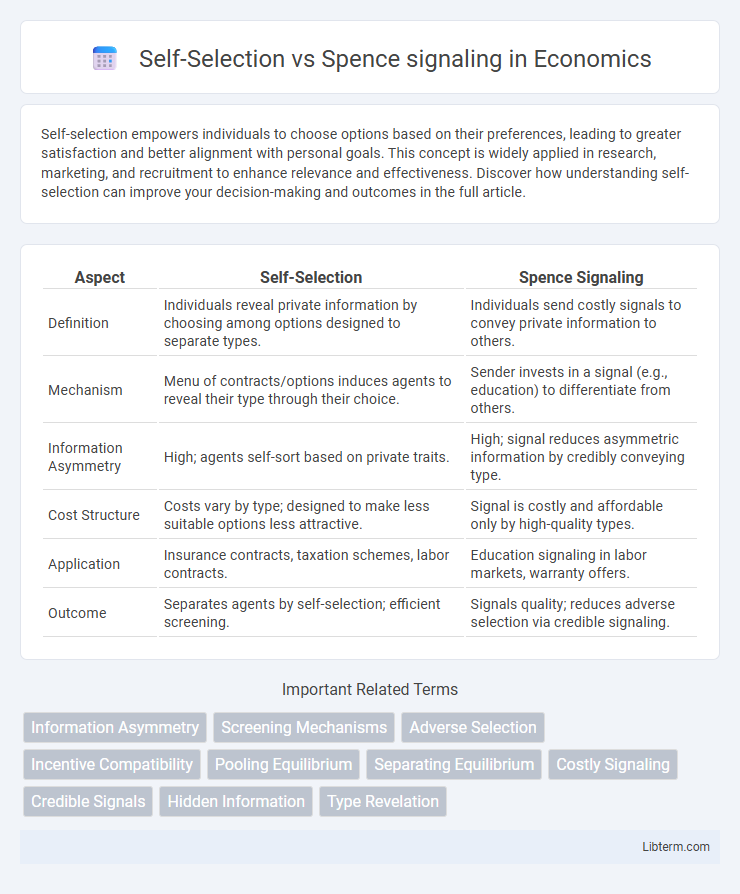Self-selection empowers individuals to choose options based on their preferences, leading to greater satisfaction and better alignment with personal goals. This concept is widely applied in research, marketing, and recruitment to enhance relevance and effectiveness. Discover how understanding self-selection can improve your decision-making and outcomes in the full article.
Table of Comparison
| Aspect | Self-Selection | Spence Signaling |
|---|---|---|
| Definition | Individuals reveal private information by choosing among options designed to separate types. | Individuals send costly signals to convey private information to others. |
| Mechanism | Menu of contracts/options induces agents to reveal their type through their choice. | Sender invests in a signal (e.g., education) to differentiate from others. |
| Information Asymmetry | High; agents self-sort based on private traits. | High; signal reduces asymmetric information by credibly conveying type. |
| Cost Structure | Costs vary by type; designed to make less suitable options less attractive. | Signal is costly and affordable only by high-quality types. |
| Application | Insurance contracts, taxation schemes, labor contracts. | Education signaling in labor markets, warranty offers. |
| Outcome | Separates agents by self-selection; efficient screening. | Signals quality; reduces adverse selection via credible signaling. |
Introduction to Self-Selection and Spence Signaling
Self-selection and Spence signaling are key concepts in information economics addressing asymmetric information between parties. Self-selection allows individuals to reveal private information through their choices, enabling efficient sorting based on preferences or characteristics. Spence signaling involves one party conveying credible information to another through costly signals, such as education credentials, to differentiate themselves in markets like employment.
Defining Self-Selection in Economics
Self-selection in economics refers to a process where individuals use private information to make decisions that reveal their own characteristics or preferences, influencing outcomes in markets with asymmetric information. This concept contrasts with Spence signaling, where one party intentionally sends signals to convey information to another party. Self-selection mechanisms often lead to sorting effects, ensuring that choices made by agents correspond to their private information without requiring costly signaling.
Understanding Spence Signaling Theory
Spence Signaling Theory explains how individuals convey their hidden qualities to employers through observable signals, such as education credentials, to reduce information asymmetry in the labor market. Unlike self-selection, where individuals decide based on their own preferences or costs, signaling involves strategic actions to influence employers' perceptions. Education serves as a credible signal because obtaining it is more costly for low-ability workers, thereby separating high-ability candidates from others.
Key Differences between Self-Selection and Spence Signaling
Self-Selection involves individuals revealing private information through their choices or actions, allowing natural sorting without direct signaling, while Spence Signaling relies on costly signals to convey information and influence perceptions in asymmetric information scenarios. Self-Selection emphasizes the role of incentives and contracts to induce truthful revelation, whereas Spence Signaling focuses on the strategic use of signals to separate types based on their willingness to bear signaling costs. The key difference lies in Self-Selection's indirect mechanism versus Spence Signaling's direct communication through observable costly actions or traits.
Mechanisms Behind Self-Selection
Self-selection operates through individuals revealing private information by making choices that reflect their true characteristics or preferences, effectively separating themselves into distinct groups based on their actions. This mechanism hinges on incentive-compatible signals where participants incur costs or benefits aligned with their types, ensuring authenticity in signaling. In contrast, Spence signaling involves deliberate signals sent to influence perceptions, often requiring costly or credible actions to convince others of hidden qualities.
The Process of Spence Signaling in Labor Markets
The process of Spence signaling in labor markets involves job candidates acquiring and presenting educational credentials or certifications as signals of their underlying ability to potential employers. These signals differentiate high-ability workers from low-ability ones by conveying credible information that reduces information asymmetry between employers and job seekers. Employers then use these observable signals to make more informed hiring decisions, improving labor market efficiency.
Real-World Examples of Self-Selection
Self-selection occurs when individuals reveal their private information through choices, such as job applicants choosing to obtain certifications that signal competence to employers. In contrast, Spence signaling involves deliberate actions, like acquiring education credentials, intended to convey ability regardless of actual skill. Real-world examples of self-selection include insurance customers opting for higher deductibles to indicate lower risk profiles and consumers choosing premium brands that implicitly reflect their preferences and income.
Practical Applications of Spence Signaling
Spence signaling proves crucial in labor markets where job applicants use education credentials to indicate productivity to employers, influencing hiring decisions effectively. Companies employ Spence signaling by offering certifications and training programs that signal employee competence, enhancing trust and competitive advantage in talent acquisition. This signaling mechanism also extends to consumer behavior, where brand reputation signals product quality, guiding purchasing choices in crowded marketplaces.
Advantages and Limitations of Each Mechanism
Self-selection enables individuals to reveal their private information through their choices, reducing information asymmetry with minimal signaling costs but may result in inefficiencies if options are poorly designed or misinterpreted. Spence signaling allows high-quality agents to credibly convey their type via costly signals, promoting market separation though it often entails wasteful expenditure and may exclude capable agents unable to afford signaling costs. Both mechanisms enhance market efficiency by addressing hidden information, yet self-selection depends on incentive-compatible mechanisms and Spence signaling requires signal credibility to function effectively.
Choosing Between Self-Selection and Spence Signaling
Choosing between self-selection and Spence signaling hinges on the nature of information asymmetry and the incentives involved. Self-selection leverages contract design to induce agents to reveal private information through their choices, optimizing outcomes under hidden characteristics. Spence signaling relies on costly signals, such as education or certifications, to communicate quality, effective when direct verification is impractical and signaling costs correlate with agent type.
Self-Selection Infographic

 libterm.com
libterm.com